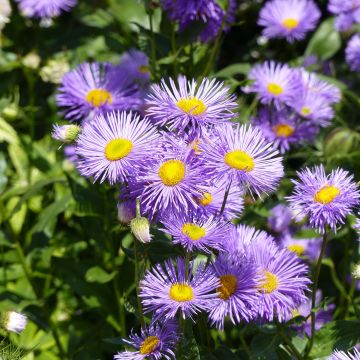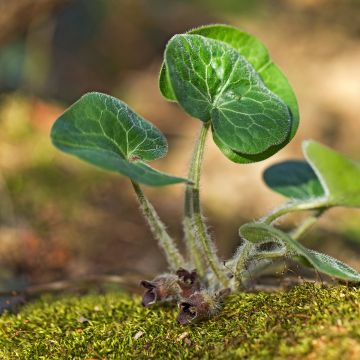

Erigeron karvinskianus Lavender Lady


Erigeron karvinskianus Lavender Lady
Erigeron karvinskianus Lavender Lady
Erigeron karvinskianus Lavender Lady
Mexican fleabane, Wall Daisy
This item cannot be shipped to the selected country
Delivery charge from €5.90
More information
Schedule delivery date,
and select date in basket
This plant carries a 12 months recovery warranty
More information
We guarantee the quality of our plants for a full growing cycle, and will replace at our expense any plant that fails to recover under normal climatic and planting conditions.
From €5.90 for pickup delivery and €6.90 for home delivery
Express home delivery from €8.90.
Does this plant fit my garden?
Set up your Plantfit profile →
Description
Erigeron karvinskianus Lavender Lady is a delightful form with lavender pink flowers. It particularly enjoys limestone rockeries and produces small flowers resembling delicate daisies, ranging in colour from pink to mauve. This little plant loves rocky places so much that it enthusiastically self-seeds, dotting stair steps, wall cracks, or dry slopes with light tufts that bloom from spring to autumn.
Erigeron karvinskianus is native to the mountains of Mexico and Central America. It belongs to the large family of Asteraceae, as evidenced by its inflorescences organized in heads like asters. It is a perennial plant with flexible and branching stems, forming a low and dense mass, more or less spread out, 30 cm (12in) in height and 40 cm (16in) in width. Lateral growth is ensured by underground rhizomes. The stems are densely covered with tiny dark green oval and pointed leaves, gathered in small groups. They persist in winter down to -5°C. Flowering begins in May-June depending on the regions and continues until October, or even until December in warmer regions. The plant produces a multitude of 1 cm (0.5 in) diameter flowers in heads, ranging in colour from pink to mauve, centred around a small yellow heart. When the summer is very dry, flowers can dry up and resumes only with the return of rain. Once pollinated by insects, the flowers give way to a multitude of seeds with white bristles that will be dispersed by the wind. They will easily germinate along paths, between paving stones, in the gaps of dry stone walls... It is a generous plant and very easy to grow, but somewhat sensitive to cold: its hardiness is around -10 to -12°C in well-draining soil.
A sun-loving perennial, preferring slightly arid places neglected by other plants, this little creeping fleabane Lavender Lady forms absolutely delightful groundcover. Plant Erigeron karvinskianus along pathways, in rockeries, above or along a wall. For example, combine it with Nepeta racemosa, Bloody Cranesbill, Feather Grass, Headed Thyme, lovely low-growing plants that appreciate the same environments and also tolerate summer drought.
Report an error about the product description
Erigeron karvinskianus Lavender Lady in pictures




Flowering
Foliage
Plant habit
Botanical data
Erigeron
karvinskianus
Lavender Lady
Asteraceae
Mexican fleabane, Wall Daisy
Central America
Other Erigeron - Fleabane
Planting and care
Plant this Erigeron Lavender Lady in March in cooler regions, or in September-October in our warm and dry regions in summer. Choose a sunny location. This perennial clearly prefers limestone or neutral, well-drained soils, even rocky, stony or sandy ones. It willingly settles in wall crevices if its roots can find some depth and coolness. Once well established, this plant can completely do without watering in summer, even in the Mediterranean region, which is very dry in summer. You can optionally cut the faded flowers to extend the flowering period. Easy to grow, it requires no particular care, but is sensitive to excessive moisture in winter. You can easily divide the clumps in spring. Spontaneous seedlings are not uncommon in light soil, in the crevices of walls... The hardiness of this plant is around -10 to -12°C (14 to 10.4°F) at its lowest, in a soil that does not retain water.
Planting period
Intended location
Care
-
, onOrder confirmed
Reply from on Promesse de fleurs
Spring flowering perennials
Haven't found what you were looking for?
Hardiness is the lowest winter temperature a plant can endure without suffering serious damage or even dying. However, hardiness is affected by location (a sheltered area, such as a patio), protection (winter cover) and soil type (hardiness is improved by well-drained soil).

Photo Sharing Terms & Conditions
In order to encourage gardeners to interact and share their experiences, Promesse de fleurs offers various media enabling content to be uploaded onto its Site - in particular via the ‘Photo sharing’ module.
The User agrees to refrain from:
- Posting any content that is illegal, prejudicial, insulting, racist, inciteful to hatred, revisionist, contrary to public decency, that infringes on privacy or on the privacy rights of third parties, in particular the publicity rights of persons and goods, intellectual property rights, or the right to privacy.
- Submitting content on behalf of a third party;
- Impersonate the identity of a third party and/or publish any personal information about a third party;
In general, the User undertakes to refrain from any unethical behaviour.
All Content (in particular text, comments, files, images, photos, videos, creative works, etc.), which may be subject to property or intellectual property rights, image or other private rights, shall remain the property of the User, subject to the limited rights granted by the terms of the licence granted by Promesse de fleurs as stated below. Users are at liberty to publish or not to publish such Content on the Site, notably via the ‘Photo Sharing’ facility, and accept that this Content shall be made public and freely accessible, notably on the Internet.
Users further acknowledge, undertake to have ,and guarantee that they hold all necessary rights and permissions to publish such material on the Site, in particular with regard to the legislation in force pertaining to any privacy, property, intellectual property, image, or contractual rights, or rights of any other nature. By publishing such Content on the Site, Users acknowledge accepting full liability as publishers of the Content within the meaning of the law, and grant Promesse de fleurs, free of charge, an inclusive, worldwide licence for the said Content for the entire duration of its publication, including all reproduction, representation, up/downloading, displaying, performing, transmission, and storage rights.
Users also grant permission for their name to be linked to the Content and accept that this link may not always be made available.
By engaging in posting material, Users consent to their Content becoming automatically accessible on the Internet, in particular on other sites and/or blogs and/or web pages of the Promesse de fleurs site, including in particular social pages and the Promesse de fleurs catalogue.
Users may secure the removal of entrusted content free of charge by issuing a simple request via our contact form.
The flowering period indicated on our website applies to countries and regions located in USDA zone 8 (France, the United Kingdom, Ireland, the Netherlands, etc.)
It will vary according to where you live:
- In zones 9 to 10 (Italy, Spain, Greece, etc.), flowering will occur about 2 to 4 weeks earlier.
- In zones 6 to 7 (Germany, Poland, Slovenia, and lower mountainous regions), flowering will be delayed by 2 to 3 weeks.
- In zone 5 (Central Europe, Scandinavia), blooming will be delayed by 3 to 5 weeks.
In temperate climates, pruning of spring-flowering shrubs (forsythia, spireas, etc.) should be done just after flowering.
Pruning of summer-flowering shrubs (Indian Lilac, Perovskia, etc.) can be done in winter or spring.
In cold regions as well as with frost-sensitive plants, avoid pruning too early when severe frosts may still occur.
The planting period indicated on our website applies to countries and regions located in USDA zone 8 (France, United Kingdom, Ireland, Netherlands).
It will vary according to where you live:
- In Mediterranean zones (Marseille, Madrid, Milan, etc.), autumn and winter are the best planting periods.
- In continental zones (Strasbourg, Munich, Vienna, etc.), delay planting by 2 to 3 weeks in spring and bring it forward by 2 to 4 weeks in autumn.
- In mountainous regions (the Alps, Pyrenees, Carpathians, etc.), it is best to plant in late spring (May-June) or late summer (August-September).
The harvesting period indicated on our website applies to countries and regions in USDA zone 8 (France, England, Ireland, the Netherlands).
In colder areas (Scandinavia, Poland, Austria...) fruit and vegetable harvests are likely to be delayed by 3-4 weeks.
In warmer areas (Italy, Spain, Greece, etc.), harvesting will probably take place earlier, depending on weather conditions.
The sowing periods indicated on our website apply to countries and regions within USDA Zone 8 (France, UK, Ireland, Netherlands).
In colder areas (Scandinavia, Poland, Austria...), delay any outdoor sowing by 3-4 weeks, or sow under glass.
In warmer climes (Italy, Spain, Greece, etc.), bring outdoor sowing forward by a few weeks.
























































